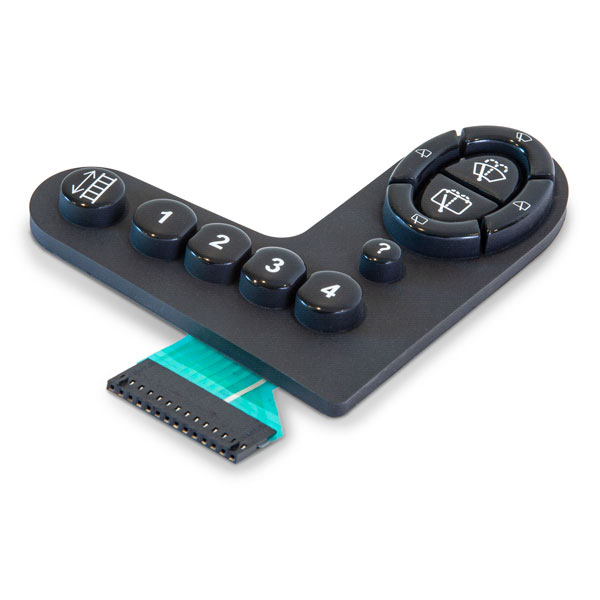Innovative Membrane Switch Solutions for Customized Control Panels
Innovative Membrane Switch Solutions for Customized Control Panels
Blog Article
Comprehending Membrane Layer Switches: The Trick to Dependable and sturdy Controls

What Are Membrane Layer Switches?
Membrane buttons are a sophisticated option in the world of user interface modern technology, combining performance and design flawlessly. These tools work as a user interface between customers and electronic systems, incorporating several parts right into a compact layout. Generally built from adaptable, thin layers of materials, membrane layer buttons are made to react to touch, enabling users to communicate with machinery and electronic devices efficiently.
The primary elements of a membrane button consist of a published circuit layer, visuals overlay, and a spacer layer that protects against unplanned activation. The visuals overlay can be tailored to show brand identity or user preferences, enhancing appearances while ensuring usability. Membrane layer buttons are typically used in various applications, consisting of clinical gadgets, consumer electronics, and industrial equipment, owing to their toughness and resistance to ecological aspects such as dampness and dirt.
One of the key benefits of membrane layer switches is their capacity to stand up to deterioration, making them perfect for high-traffic environments. In addition, they are lightweight and call for very little space, permitting ingenious layouts in product development. Generally, membrane switches over represent a sensible and effective option for modern-day electronic user interfaces, marrying technology with user-centric style principles.
Just How Membrane Changes Work
The operation of membrane layer switches over hinges on a straightforward yet reliable mechanism that converts individual input right into electronic signals. When a customer presses the button, the leading layer warps, permitting a conductive aspect in the circuit layer to make call with a corresponding conductive pad on the bottom of the visuals overlay.
The design of membrane layer buttons can vary, yet they frequently include domes or tactile elements to supply comments to the customer, enhancing the overall experience - membrane switch. The products made use of in membrane switches, such as polyester or polycarbonate, add to their longevity and resistance to environmental factors, including wetness and dirt. Additionally, the published circuits are usually enveloped, which safeguards them from deterioration gradually.
Advantages of Membrane Layer Buttons

Additionally, membrane buttons are recognized for their click this site toughness. Created from robust materials, they are resistant to dust, moisture, and physical wear, which considerably prolongs their life expectancy contrasted to typical mechanical buttons. This durability makes them particularly suitable for high-traffic environments and applications requiring longevity.
Another significant benefit is the ease of cleansing and upkeep. The smooth surface area of membrane layer changes lessens dust accumulation and is commonly invulnerable to spills, making them suitable for setups that call for regular sanitization.
In addition, membrane layer buttons use a structured profile, resulting in a thinner design that can be integrated into various tools without including bulk. This feature not just improves the aesthetic appeal but also adds to a much more ergonomic item style.
Applications of Membrane Buttons
Straightforward and functional, membrane buttons locate applications across a wide array of industries, including clinical gadgets, customer electronic devices, and industrial tools. In the medical area, these switches are integral to tools such as diagnostic tools, client monitoring systems, and mixture pumps, where reliability and convenience of cleaning are critical. Their capacity to keep and endure harsh settings functionality makes them ideal for such applications.

In consumer electronic devices, membrane layer switches are utilized in items like microwaves, washing equipments, and push-button controls - membrane switch. Their sleek layout permits instinctive individual interfaces, boosting the general user experience while supplying resilience and resistance to tear and use
Commercial equipment additionally profits from membrane switches, especially in control panels for equipment and automation systems. These buttons offer security versus dirt and moisture, making certain consistent performance in tough environments. Moreover, their customizable functions permit manufacturers to tailor them to certain functional demands, boosting efficiency and performance.
Selecting the Right Membrane Layer Change
When picking a membrane layer button, it is vital to consider numerous variables that affect efficiency and viability for certain applications. The main considerations include environmental problems, responsive comments, toughness, and layout specifications.
First, analyze the operating environment; buttons exposed to moisture, chemicals, or severe temperature levels require certain products to guarantee long life and capability. Next, evaluate the demand for responsive feedback. Relying on individual interaction, some applications might gain from a tactile feedback to verify activation, while others may favor a non-tactile style for aesthetic factors.
Toughness is another crucial variable; membrane buttons try these out must be developed to withstand constant use, impacts, and abrasion. Make sure the chosen switch can withstand the expected lifecycle, specifically in high-usage circumstances.
Conclusion
In conclusion, membrane changes offer as vital parts in the design of reputable and sturdy control systems across different sectors. The convenience of membrane changes permits for customized solutions that meet certain functional demands, reinforcing their importance in contemporary innovation.
Membrane layer switches over stand for a crucial element of contemporary user interface layout, mixing functionality with resilience in numerous applications.Membrane layer switches are an innovative solution in the realm of user interface innovation, integrating performance and layout effortlessly. Typically constructed from adaptable, slim layers of products, membrane layer buttons are created to react to touch, allowing individuals to communicate with machinery and electronic devices effectively.
The layout of membrane Get More Info layer buttons can differ, however they typically integrate domes or tactile elements to give responses to the individual, improving the overall experience.In conclusion, membrane layer switches over offer as vital elements in the design of dependable and durable control systems throughout numerous markets.
Report this page